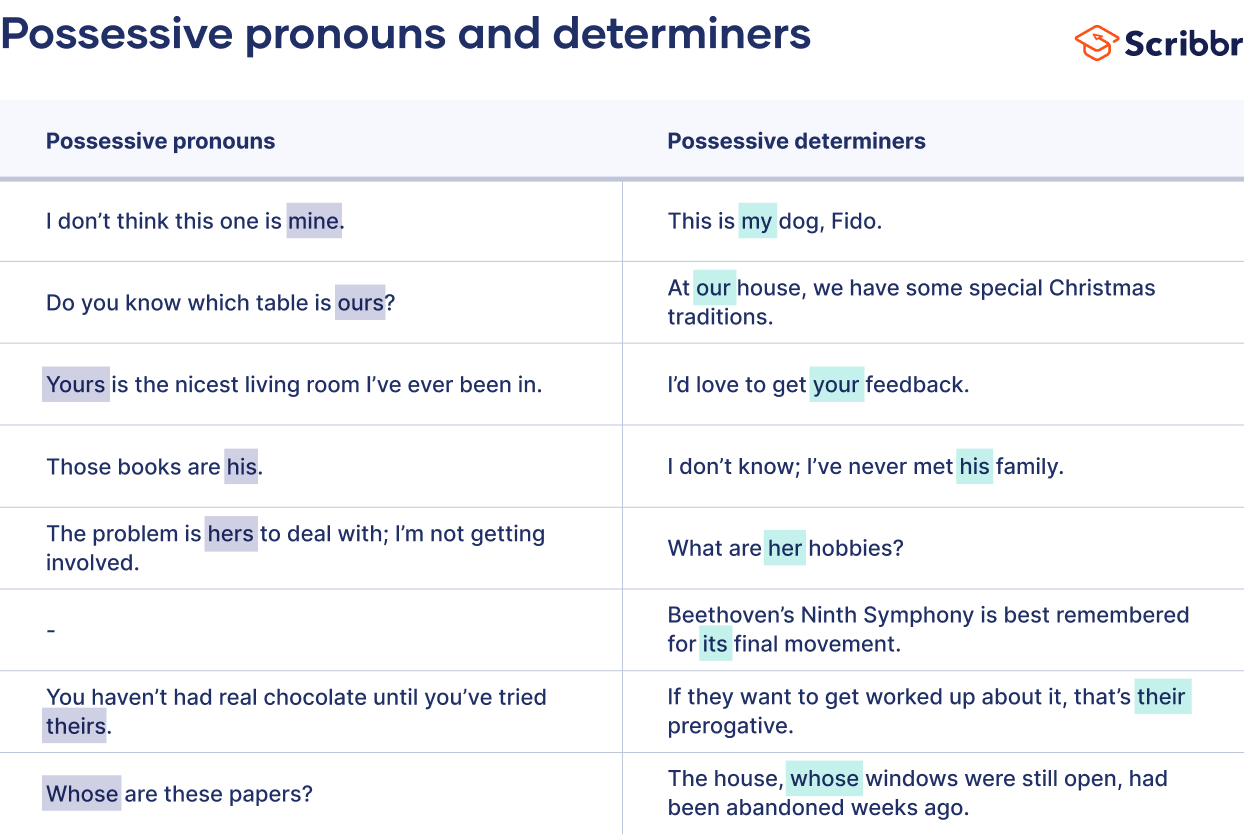Possessive Pronouns | Examples, Definition & List
Possessive pronouns are pronouns that are used to indicate the ownership (possession) of something or someone by something or someone else. The English possessive pronouns are mine, ours, yours, his, hers, theirs, and whose.
Possessive pronouns are closely related to possessive determiners, which are used differently since they appear before a noun instead of replacing it. The possessive determiners are my, our, your, his, her, its, their, and whose.
How are possessive pronouns used in sentences?
Possessive pronouns are used in place of nouns to make statements about ownership more concisely, without needing to repeat the nouns representing the owner and the possession:
- Randall says that the pencil case is Randall’s pencil case.
- Randall says that the pencil case is his.
‘Possession’ in the context of possessive pronouns and determiners can mean literal ownership of something (e.g., a book, a company), but it can also indicate more figurative kinds of possession, such as the possession of a relationship with someone or some place.
I want to be yours forever. Will you marry me?
He really missed his hometown.
She thought that no boss could be worse than hers.
Agreement with the antecedent
The antecedent of a possessive pronoun is the person or thing that possesses what- or whomever is being referred to. For example, in the statement ‘Diana says that the car is hers’, the antecedent of ‘hers’ is ‘Diana’, the owner of the car.
The possessive pronoun (or determiner) must show correct pronoun-antecedent agreement in person, gender, and number. The possessive pronoun ‘hers’, for example, is feminine (because Diana is female), third-person (because the speaker is not Diana and is not addressing her directly), and singular (because Diana is one person).
I like my car, but I wish my parents would let me drive theirs sometimes.
The building is about to collapse under its own weight.
Subject-verb agreement
Because of the rules of subject-verb agreement, any possessive pronoun that is used as the subject of a sentence can be followed by either a singular or a plural verb form depending on whether what it refers to (i.e., the thing possessed, not the possessor) is singular or plural.
I know you’re a bit scared of dogs, but I promise mine are really friendly.
Possessive pronouns vs determiners
Possessive pronouns and possessive determiners are closely related and sometimes identical in spelling, but they play different grammatical roles.
- Possessive pronouns always stand on their own, not modifying a noun but replacing one.
- Possessive determiners (sometimes called possessive adjectives) instead modify a noun that comes after them.
Because possessive pronouns don’t allow you to specify what the possession in question is, you should use them only when this is already clear from the context. Otherwise, use a possessive determiner followed by a noun specifying the identity of the possession.
- Once each participant had finished theirs, they could move on to the next task.
- Once each participant had finished their questionnaire, they could move on to the next task.
Its vs it’s
Its and it’s are commonly confused, but they have quite different meanings.
- Its is the correct spelling of the possessive determiner used to indicate something belonging to an animal or thing.
- It’s is a shortening of the phrase ‘it is’ or ‘it has’. The apostrophe is used to indicate that it’s a contraction – not to indicate possession.
It’s best to get a good night’s sleep before your exam.
Though possession is marked with an apostrophe in possessive nouns (e.g., ‘Jeremy’s dad’s house’s garage’), this is not how possessive pronouns are formed. This means that spellings such as ‘your’s’, ‘their’s’, ‘our’s’, and ‘her’s’ are always wrong.
Whose
Unlike the other possessives, whose is not classed as a personal pronoun but as an interrogative pronoun or a relative pronoun. It can also be used as an interrogative or relative determiner.
- Interrogative pronouns and determiners introduce a direct or indirect question.
- Relative pronouns and determiners introduce a relative clause that provides more information about a noun phrase.
I wonder whose entry will win the competition.
The man whose dog was reported lost last week still hasn’t been reunited with it.
The chair, one of whose legs has fallen off, is quite unstable.
Frequently asked questions
Sources for this article
We strongly encourage students to use sources in their work. You can cite our article (APA Style) or take a deep dive into the articles below.
This Scribbr articleCaulfield, J. (2023, September 11). Possessive Pronouns | Examples, Definition & List. Scribbr. Retrieved 9 April 2025, from https://www.scribbr.co.uk/nouns/possessive-pronouns/
Aarts, B. (2011). Oxford modern English grammar. Oxford University Press.
Butterfield, J. (Ed.). (2015). Fowler’s dictionary of modern English usage (4th ed.). Oxford University Press.
Garner, B. A. (2016). Garner’s modern English usage (4th ed.). Oxford University Press.




